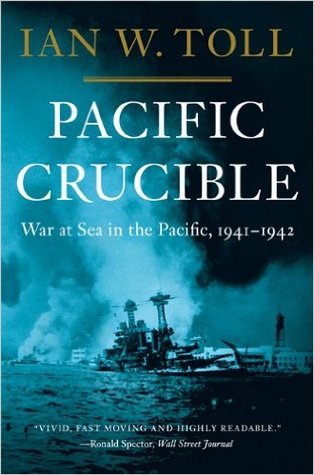More on this book
Community
Kindle Notes & Highlights
by
Ian W. Toll
Read between
August 9 - August 13, 2020
but the legislature never grew powerful enough to confront the supreme power of the bureaucracy. There was never, in any sense, civilian control of the military, which remained supreme in both name and fact, and enjoyed a special direct advisory relationship with the throne.
a little before eight in the morning on that first Sunday in December 1941,
The room, observed BBC correspondent Alistair Cooke, “already had that air of tobacco-choked energy that is the Washington odor of panic.”
“Yesterday, December seventh, nineteen forty-one—a date which will live in infamy—the United States of America was suddenly and deliberately attacked by naval and air forces of the Empire of Japan.”
until they had subjugated and destroyed “the Anglo-Saxon–Jewish–Capitalist World.”
With the May 15 incident, a Rubicon had been crossed. The assassination effectively marked a new era of military domination of the Japanese government.
the prime minister and other cabinet heads would generally not be selected from the Diet at all, but from the ranks of the military or the court aristocracy.
using the time-honored techniques of passive resignation and appeasement, always hoping that the storm would abate and the militant nationalists would fade into impotence.
The two services were pitted against each other in an eternal brawl over funding, political influence, and the allocation of resources.
there was no one in Japan—no office, no agency, no legislature, no dictator, no commander in chief—who could overrule the army or navy when their institutional priorities did not fit into a coherent national policy. The predictable upshot was that both services got what they wanted.
1940, American sanctions brought the essential questions of war and peace out of the realm of long-term planning and into the sphere of immediate decision.
Navy leaders did not want war with the United States, but could not bring themselves to kill the goose that laid the golden eggs.
We were afraid that the army would say, ‘If the navy can’t fight, give us your materiel and budget.’”
the army will grasp Japan’s total national strength and financial power for its own purposes.”
300,000 tons of steel would buy the navy’s support for the war it did not really want to fight.
Secretary of State Hull did not waver from his position that the sanctions would continue until Japanese troops were pulled out of China.
In October, Tojo forced Prince Konoye out of office and assumed the office of prime minister himself (while maintaining the office of army minister).
The general was now the dominant figure in Japanese politics, and he was determined to take the country to war:
The ears of the Japanese people were ringing with propaganda calculated to arouse them to war, and they never heard a dissenting point of view.
The oil embargo amounted to a slow strangulation of the Japanese economy:
navy leaders believed that the alternative to a foreign war might be a civil war.
Still, the disagreeable questions remained: How was the U.S. Navy caught so utterly off guard? Who was at fault and who was going to be called to account for the catastrophe?
to secure the seaways between Midway, Hawaii, and the North American mainland. That was to be his first priority. His second priority, in only a “small degree less important,” was to protect the lifeline between North America and Australia, chiefly by “covering, securing, and holding the Hawaii-Samoa line,
That long supply line must safely accommodate a large and growing volume of shipping. By
The U.S. Asiatic Fleet—a ramshackle array of old cruisers and destroyers—would probably be annihilated by the enemy’s ships and planes.
Its main contribution to the war effort would be to slow the rate of the Japanese advance and buy a few precious weeks to secure the seaways linking San Francisco, San Diego, and Panama to Brisbane, Auckland, and Sydney.
was concerned that the chiefs were neglecting the need to stem the Japanese tide.
King would never consent to place the Pacific Fleet under the command of the messianic, fame-seeking General MacArthur.
Hypo’s chief was Joseph Rochefort, a forty-one-year-old navy commander.
Fortunately for Hypo, and the navy, and the United States, Chester Nimitz was not such an admiral.
Raw intercepts of any kind were potentially useful to the codebreakers, but transmissions linked to known events in a known geographic location were invaluable. In such messages one found the same recurring externals: geographic designators obviously pointing to the Marshall Islands; radio call signs for Japanese ships, units, and commanders known to be present at the time of the raid; and code groups referring to enemy aircraft carriers.
At this precarious juncture, with the war hanging in the balance, Nimitz chose to bet his command on the accuracy of the intelligence.
With King’s go-ahead, Nimitz returned to Pearl on April 28 and issued plans and orders for the approaching Battle of the Coral Sea.
the most confused and confusing battles in the history of war at sea, characterized on both sides by an almost incredible series of miscues, miscommunications, misidentifications, misinterpretations, and miscalculations.
In arranging his forces, Nimitz had concentrated on one overriding objective to the exclusion of all others: to ambush and destroy the Japanese carriers.
Yamamoto’s plan was vast and fatally complex,
Nimitz’s was straightforward, and aimed at the enemy’s mos...
This highlight has been truncated due to consecutive passage length restrictions.


